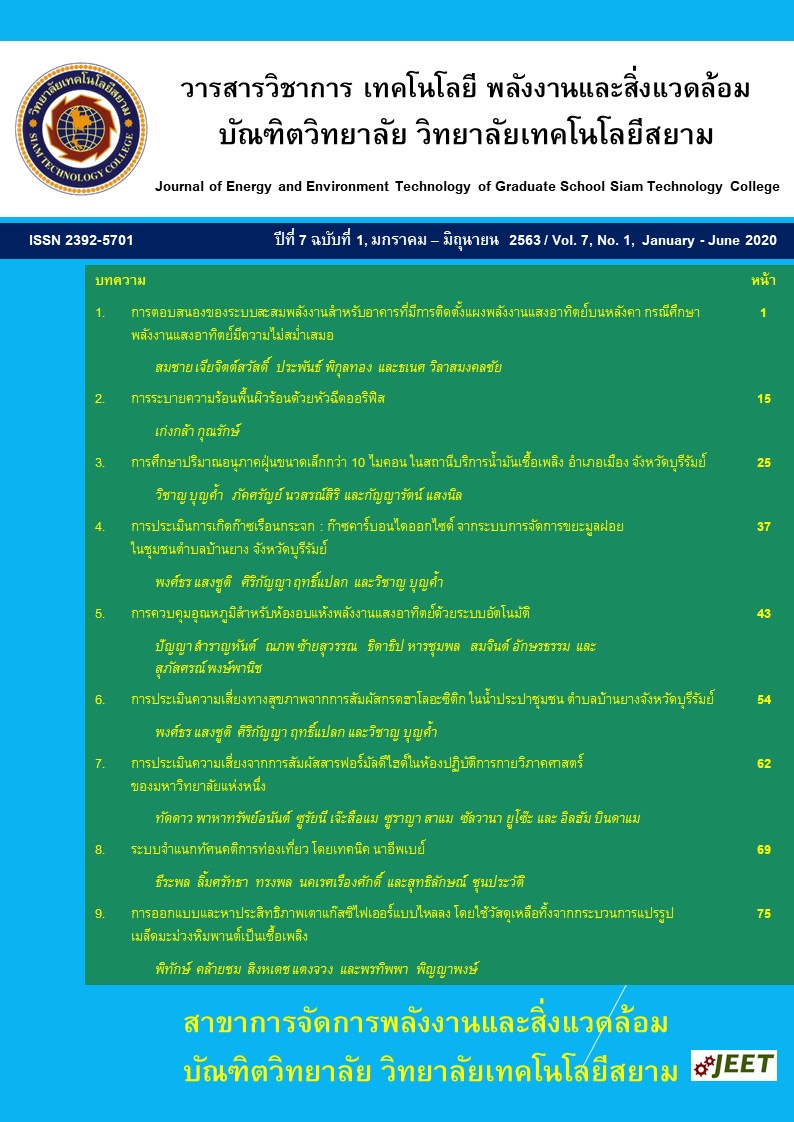TOURISM ATTITUDE CLASSIFICATION SYSTEM USING NAIVE BAYES TECHNIQUE
Main Article Content
Abstract
The purposes of this research study are to develop the program for distinguishing the positive and negative tourism attitudes by using the Naive Bayes technique and to evaluate the efficiency of the tourism attitude system by using accuracy matrices, recognitions, F-measure and correctness. The data were Thai tourists' reviews about domestic tourism from Google Map and TripAdvisor website. It was found that the program could analyze and distinguish the feelings from general texts. However, there might be problems about sentences with unclear sentences and phrases such as not really bad. These texts were problematic for cutting words and interpreting by the program. Consequently, scores are incorrect. By evaluating the efficiency of the system with 120 different documents for creating models; the recognition, accuracy and F-measure values are 80, 100 and 120, respectively. The averages from the three models are as follows. The average recognition is 0.86. The average accuracy is 0.80. The average F-measure is 0.80. The average correctness is 0.80.
Article Details
เนื้อหาและข่อมูลในบทความที่ลงตีพิมพ์ในวารสารวิชาการ เทคโนโลยี พลังงาน และสิ่งแวดล้อม บัณฑิตวิทยาลัย วิทยาลัยเทคโนโลยีสยาม ถือเป็นข้อคิดเห็นและความรับผิดชอบของผู้เขียนบทความโดยตรง ซึ่งกองบรรณาธิการวารสารไม่จำเป็นต้องเห็นด้วย หรือว่าร่วมรับผิดชอบใด ๆ
บทความ ข้อมูล เนื้อหา รูปภาพ ฯลฯ ที่ได้รับการตีพิมพ์ในวารสารวิชาการ เทคโนโลยี พลังงาน และสิ่งแวดล้อม บัณฑิตวิทยาลัย วิทยาลัยเทคโนโลยีสยาม ถือเป็นลิขสิทธิ์ของวารสารวิชาการ เทคโนโลยี พลังงาน และสิ่งแวดล้อม บัณฑิตวิทยาลัย วิทยาลัยเทคโนโลยีสยาม หากบุคคล หรือหน่วยงานใดต้องการนำทั้งหมด หรือส่วนหนึ่งส่วนใดไปเผยแพร่ต่อ หรือเพื่อกระทำการใด ๆ จะต้องได้รับอนุญาต เป็นลายลักษณ์อักษรจากวารสารวิชาการ เทคโนโลยี พลังงาน และสิ่งแวดล้อม บัณฑิตวิทยาลัย วิทยาลัยเทคโนโลยีสยาม เท่านั้น
References
รวิสุดา และ นิเวศ. (2560). การวิเคราะห์ความคิดเห็นภาษาไทยเกี่ยวกับการรีวิวสินค้าออนไลน์ โดยใช้ขั้นตอนวิธีซัพพอร์ตเวกเตอร์แมทชีน. สืบค้นวันที่ 5 พฤศจิกายน 2561, จาก ejsu.siam.edu/journals/PDF_34/EJSU_No.34_pp_1-12.pdf
วรัญญา. (2553). ระบบวิเคราะห์ข้อความแสดงความคิดเห็นสำหรับโรงแรม. สืบค้นวันที่ 5 พฤศจิกายน 2561, จาก
thailang.nectec.or.th/halloffame/images/stories/best/download/13p33c001.pdf/
วรรณพงษ์. (2558). การประมวลภาษาธรรมชาติด้วยภาษาไพทอน. สืบค้นวันที่ 5 พฤศจิกายน 2561, จาก https://python3.wannaphong.com/2015/10/blog-post.html
วรรณพงษ์. (ม.ป.ป). คู่มือการใช้งาน PyThaiNLP 1.4. สืบค้นวันที่ 5 พฤศจิกายน 2561, จาก https://pythainlp.readthedocs.io/en/latest/pythainlp-1-4-thai/
Kasidis. (2560). อธิบาย 10 Metrics พื้นฐานสำหรับวัดผลโมเดล Machine Learning. สืบค้นวันที่ 8 สิงหาคม 2562, จาก
https://datarockie.com/2019/03/30/top-ten-machine-learning-metrics/
เจตรินทร์ วงศ์ศิลป์ ณัฐกิตติ์ ศรีกาญจนเพริศ และจันทิมา พลพินิจ (2560) . การวิเคราะห์ความรู้สึกแบบอัตโนมัติจากข้อความแสดงความคิดเห็น. ใน การประชุมวิชาการระดับชาติด้านคอมพิวเตอร์และเทคโนโลยีสารสนเทศ ครั้งที่ 15 (NCCIT2015). หน้า 1-6. กรุงเทพฯ: คณะเทคโนโลยีสารสนเทศ มหาวิทยาลัยเทคโนโลยีพระจอมเกล้าพระนครเหนือ.
อิสรรูป ล้อรัตนไชยยงค์. (2560) การสร้างคลังคำศัพท์บอกความรู้สึกในภาษาไทยจากบทวิจารณ์ออนไลน์ [อ.ม. สาขาภาษาศาสตร์]. กรุงเทพฯ: คณะอักษรศาสตร์ จุฬาลงกรณ์มหาวิทยาลัย.


